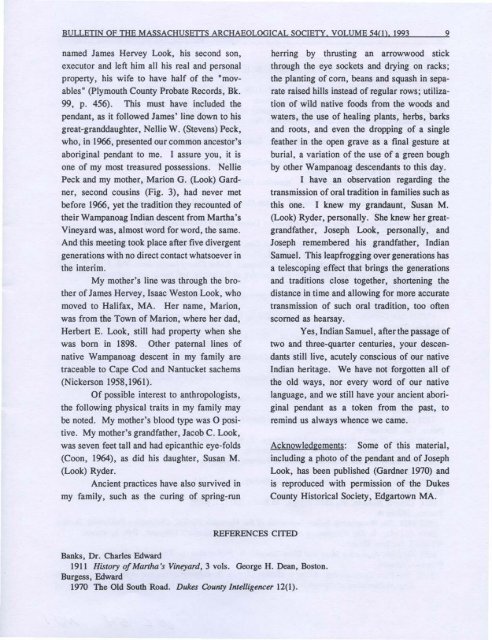Bulletin of the Massachusetts Archaeological Society, Vol. 54, No. 1 ...
Bulletin of the Massachusetts Archaeological Society, Vol. 54, No. 1 ...
Bulletin of the Massachusetts Archaeological Society, Vol. 54, No. 1 ...
You also want an ePaper? Increase the reach of your titles
YUMPU automatically turns print PDFs into web optimized ePapers that Google loves.
BULLETIN OF THE MASSACHUSETIS ARCHAEOLOGICAL SOCIETY. VOLUME <strong>54</strong>(1). 1993 9<br />
named James Hervey Look, his second son,<br />
executor and left him all his real and personal<br />
property, his wife to have half <strong>of</strong> <strong>the</strong> "movabies"<br />
(plymouth County Probate Records, Bk.<br />
99, p. 456). This must have included <strong>the</strong><br />
pendant, as it followed James' line down to his<br />
great-granddaughter, Nellie W. (Stevens) Peck,<br />
who, in 1966, presented our common ancestor's<br />
aboriginal pendant to me. I assure you, it is<br />
one <strong>of</strong> my most treasured possessions. Nellie<br />
Peck and my mo<strong>the</strong>r, Marion G. (Look) Gardner,<br />
second cousins (Fig. 3), had never met<br />
before 1966, yet <strong>the</strong> tradition <strong>the</strong>y recounted <strong>of</strong><br />
<strong>the</strong>ir Wampanoag Indian descent from Martha's<br />
Vineyard was, almost word for word, <strong>the</strong> same.<br />
And this meeting took place after five divergent<br />
generations with no direct contact whatsoever in<br />
<strong>the</strong> interim.<br />
My mo<strong>the</strong>r's line was through <strong>the</strong> bro<strong>the</strong>r<br />
<strong>of</strong>James Hervey, Isaac Weston Look, who<br />
moved to Halifax, MA. Her name, Marion,<br />
was from <strong>the</strong> Town <strong>of</strong> Marion, where her dad,<br />
Herbert E. Look, still had property when she<br />
was born in 1898. O<strong>the</strong>r paternal lines <strong>of</strong><br />
native Wampanoag descent in my family are<br />
traceable to Cape Cod and Nantucket sachems<br />
(Nickerson 1958,1961).<br />
Of possible interest to anthropologists,<br />
<strong>the</strong> following physical traits in my family may<br />
be noted. My mo<strong>the</strong>r's blood type was 0 positive.<br />
My mo<strong>the</strong>r's grandfa<strong>the</strong>r, Jacob C. Look,<br />
was seven feet tall and had epicanthic eye-folds<br />
(Coon, 1964), as did his daughter, Susan M.<br />
(Look) Ryder.<br />
Ancient practices have also survived in<br />
my family, such as <strong>the</strong> curing <strong>of</strong> spring-run<br />
REFERENCES CITED<br />
Banks, Dr. Charles Edward<br />
1911 History <strong>of</strong>Martha's Vineyard, 3 vols. George H. Dean, Boston.<br />
Burgess, Edward<br />
1970 The Old South Road. Dukes County Intelligencer 12(1).<br />
herring by thrusting an arrowwood stick<br />
through <strong>the</strong> eye sockets and drying on racks;<br />
<strong>the</strong> planting <strong>of</strong> corn, beans and squash in separate<br />
raised hills instead <strong>of</strong> regular rows; utilization<br />
<strong>of</strong> wild native foods from <strong>the</strong> woods and<br />
waters, <strong>the</strong> use <strong>of</strong> healing plants, herbs, barks<br />
and roots, and even <strong>the</strong> dropping <strong>of</strong> a single<br />
fea<strong>the</strong>r in <strong>the</strong> open grave as a final gesture at<br />
burial, a variation <strong>of</strong> <strong>the</strong> use <strong>of</strong> a green bough<br />
by o<strong>the</strong>r Wampanoag descendants to this day.<br />
I have an observation regarding <strong>the</strong><br />
transmission <strong>of</strong> oral tradition in families such as<br />
this one. I knew my grandaunt, Susan M.<br />
(Look) Ryder, personally. She knew her greatgrandfa<strong>the</strong>r,<br />
Joseph Look, personally, and<br />
Joseph remembered his grandfa<strong>the</strong>r, Indian<br />
Samuel. This leapfrogging over generations has<br />
a telescoping effect that brings <strong>the</strong> generations<br />
and traditions close toge<strong>the</strong>r, shortening <strong>the</strong><br />
distance in time and allowing for more accurate<br />
transmission <strong>of</strong> such oral tradition, too <strong>of</strong>ten<br />
scorned as hearsay.<br />
Yes, Indian Samuel, after <strong>the</strong> passage <strong>of</strong><br />
two and three-quarter centuries, your descendants<br />
still live, acutely conscious <strong>of</strong> our native<br />
Indian heritage. We have not forgotten all <strong>of</strong><br />
<strong>the</strong> old ways, nor every word <strong>of</strong> our native<br />
language, and we still have your ancient aboriginal<br />
pendant as a token from <strong>the</strong> past, to<br />
remind us always whence we came.<br />
Acknowledgements: Some <strong>of</strong> this material,<br />
including a photo <strong>of</strong> <strong>the</strong> pendant and <strong>of</strong> Joseph<br />
Look, has been published (Gardner 1970) and<br />
is reproduced with permission <strong>of</strong> <strong>the</strong> Dukes<br />
County Historical <strong>Society</strong>, Edgartown MA.
















